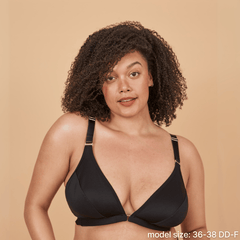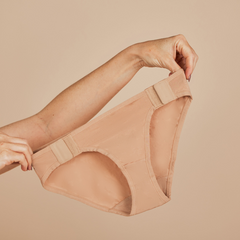Racerback, push-up, bandeau, wireless bra….with so many shapes and varying degrees of support, finding the most comfortable bra can be difficult, and often feel impossible.
Yet, having a comfortable bra that allows you to step out of the house feeling beautiful and supported is empowering. In addition, a lack of support in a bra can cause chronic neck and back pain and skin damage.
If you have a larger chest, it is especially important to have a supportive bra. Without one, over time your breasts will begin to droop and the weight bearing down on the front of your chest will lead to bad posture and even worse back pain.
While bralettes are cute and comfortable, it’s important to find the perfect band-to-cup ratio for your body and know whether they will provide the needed support.
So how can you begin to discover your perfect fit?
There are many aspects of a bra to take into consideration when trying to figure this out. The most important parts of a bra’s anatomy are the underwire, straps, gore, and the underband and wings.
Underwire

Found in every traditional bra, the underwire is a thin piece of steel within the underband that is used to provide extra support for your breasts. Yet, while it is conventional, underwires are not for everyone. In fact, there are over ten types of breast shapes and only breasts that are perfectly centered fit the underwire mold.
Take time to discover what breast shape you have to better understand your body in order to find out if a wireless bra may be a better fit for you. Luckily, there are plenty of wireless bras available and those with a molded cup will provide the most support.
Straps
Adding to the complexities of finding your perfect fit, there are many types of bra straps. Thick straps will provide you with the most support and comfort because they do not dig into or slip off your shoulders, and they help to distribute the weight of your breasts more evenly. Thin straps provide less support but may be easier to conceal when wearing certain outfits.
While straps that fit straight over your shoulders are the most common, racerback bras are also important especially for athletic activity. Unlike traditional straps, racerback bras provide compression rather than direct support and are great for strenuous activities.
Another fundamental part of the straps are what they are made of. There are varying degrees of elasticity through the straps and these are directly related to varying degrees of support. Less elastic straps will make the bra more supportive as the tougher fabric will be able to pull more weight. As such, when wearing a bra, the straps should sit as two straight lines down your back, parallel with one another. This is a sign that your bra is fitting correctly.
Gore

The gore is the center of the bra between the two cups. The larger the gore is, the more supportive the bra. If there is gapping between the top of gore and your chest, this means the bra is too big. The gore is especially important for larger chests and in plus-size bras. In these bras, the gore falls even higher on your chest, allowing the breasts to be held tighter to the chest.
Underband & Wings
The wings and underband are the fabric below the cups and underwire that wraps around you, providing most of the support in a bra. While seamless bralettes seem to overrun every intimates store nowadays, it’s important to remember that an underband with elastic and tougher fabrics is key to finding the perfect blend of comfort and support.
When you are wearing a bra, the wings should come together and sit in a straight line across your back. Any curving in the back of a fastened bra is a sign that the bra is too small or too big. In addition, a wider underband and wider wings provide more support as it further stabilizes your breasts by anchoring the bra across a larger portion of your chest and back.
Knowing the various parts of a bra and what they do is key to finding the most comfortable bra for you. At Springrose, we’re designing an adaptive bra with all this in mind. Our product will be a wireless front closure bra with thick straps and wide side bands, so that it’s both comfortable and supportive, regardless of your level of mobility or dexterity.
Bras are supposed to be made for you. Yet, we know finding a comfortable fit can be difficult. Therefore, we hope this has been helpful in understanding the various components to keep in mind next time you are buying a new bra.




